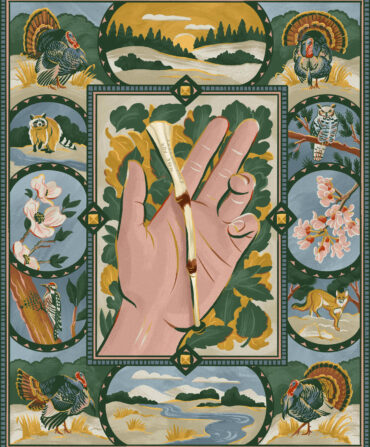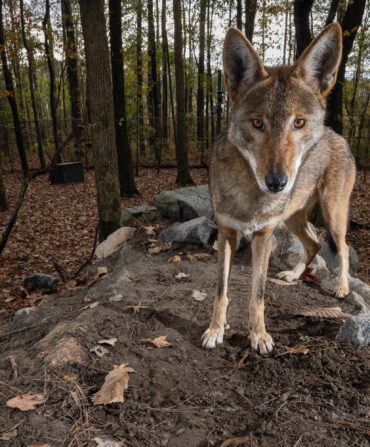Sporting
The Heart of an Angler
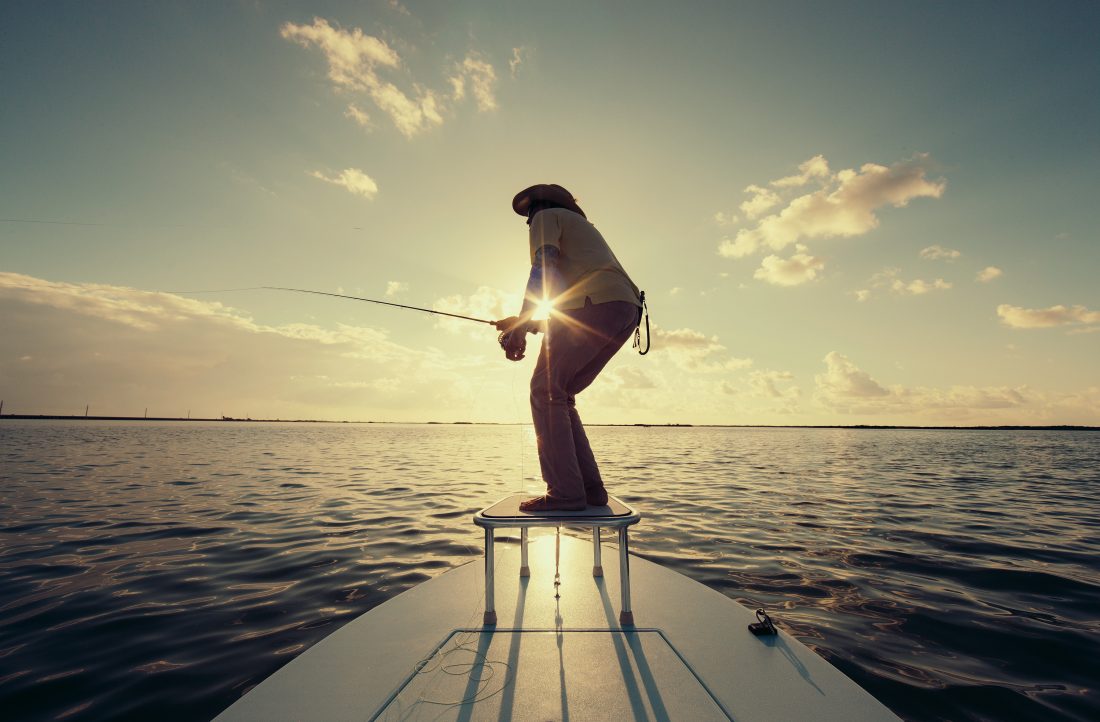
Robb Aaron Gordon
Andy Mill stands on the poling platform in the stern of his Hell’s Bay flats boat, scanning the water before him, searching for signs of tarpon. A stiff wind luffs his camouflage fishing pants like a sail and threatens to whitecap the water even in this relatively protected inner basin in the Florida Keys. Ten other tarpon boats are within view, everyone, it seems, seeking the lee. No one has caught a fish yet. A few tarpon are rolling in the distance, but nothing is happening near us. I decide to take advantage of that fact to ask Mill a question.
“Andy, what’s the key to being a great tarpon fly angler?”
Without hesitating—or taking his eyes off the water—he answers, “You have to show the fly to the fish without him seeing it.”
I look to the bow, where Mill’s son Nicky stands—compact and alert—his tarpon rod in his right hand, the fly in the fingers of his left. Nicky just nods in agreement. A few minutes later, with the Zen-like koan still bouncing around in my head, Mill suddenly and emphatically whispers: “Nicky. Off the stern. Five o’clock.”
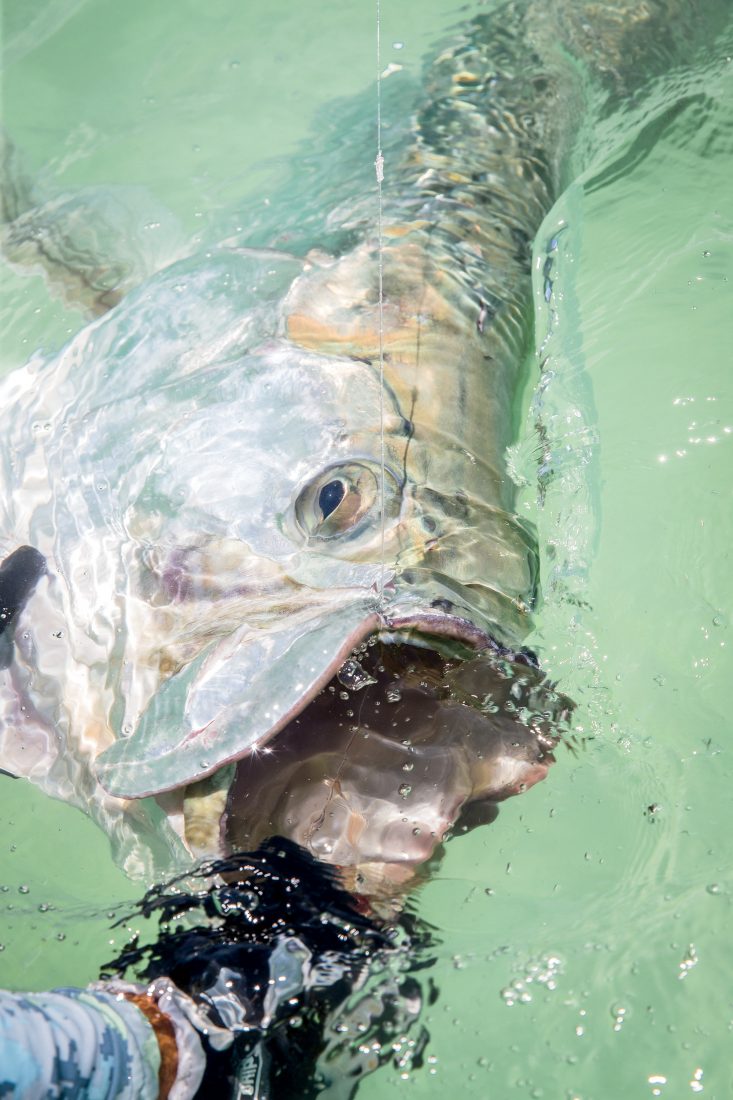
Robb Aaron Gordon
Tarpon Time
An eighty-pound silver king at boatside.
Nicky turns, spots the fish, and throws a backhanded cast. He makes one strip, his line comes tight, and the sea explodes in white froth as the fish makes the first of five miraculous, head-shaking jumps. Nicky fights the tarpon hard from the start, pinching his fly line against the butt of the rod and pulling with his entire body. Mill coaches from the stern. “Turn his head, Nicky. Turn it…Good, good.”
As the fish nears the boat, Nicky pulls even harder and the fish flips, its tail over its head—the finishing blow. “Great job, buddy!” Mill says. Anglers in the other boats have stopped casting to watch. Moments later, after just a twenty-minute fight, the one-hundred-pound fish is alongside the boat. It’s quickly revived and then disappears with a powerful flick of its tail.
“I love you, buddy,” Mill says as he embraces his son.
Andy Mill is a former member of the U.S. Ski Team, one of the best American racers of his era. He has covered some of the biggest events in sports as a broadcaster for all of the major television networks. He had a high-profile marriage to the tennis player Chris Evert, which ended in an even more high-profile—and painful—divorce.
But to those in a certain smallish but fanatical subset of this vast world, Mill is known primarily as one of the best tarpon fly anglers—if not the best—who ever lived. He’s won more tarpon tournaments than anyone else. He has come up with game-changing innovations in the sport and improved on the work of others who came before him. He’s caught thousands of tarpon. In his best year, he landed 107 in just over fifty days of fishing. A man once paid $10,000 to fish with him (Mill donated the money to an Aspen ski club). Mill’s cast, even with the big tarpon rod and a twenty-five-mile-an-hour wind in his face, is graceful and unhurried, exactly how you picture the perfect cast (his girlfriend goes so far as to describe it as “sexy”). He wrote the must-have coffee-table book A Passion for Tarpon in 2010. “As a tarpon angler, he’s so much better than anyone else that I’ve seen it’s almost unfair,” says Dustin Huff, a well-respected tarpon guide in the Keys. “He brought a lot of popularity to the sport, somewhat to my dismay as a guide. He made it look so easy and cool that everyone wanted to try it.”
Some of his fishing friends refer to Mill as Peter Pan. They mean it in a positive way. He is exuberant and exceedingly warmhearted and loves to share his knowledge. At sixty-three, he remains constantly at play (fishing, hunting, golfing, biking, skiing) and in great shape (he hiked a hundred miles bowhunting for elk last fall). His long black hair, streaked with only a few strands of white, sprouts from the top of his head and spills over his fishing visor. A few years ago, he made the AARP magazine’s list of “top 20 hottest men over 50.” Only the wrinkles near his eyes—from decades spent on water and snow—betray his age.
For the past five years, Mill and Nicky have rented a house in the lower Keys for five weeks during the spring tarpon season. They call it the Poon House. (This name is a bit less prurient than it may seem. In the fly-fishing world, poon is shorthand for tarpon.) It functions as some sort of father-son nirvana. The Mills rarely host guests or fish with anyone else down there. The kitchen table has been requisitioned as a fly-tying station, strewn with hooks and feathers. Tucked in various corners of the house and its garage are bikes, golf clubs, paddleboards, and at least three dozen rods. An opened bag of Fritos rests on a pantry shelf. Good dark rum holds down one corner of the kitchen counter. There’s an archery target in the backyard. When the neighbors are out of town, the Mills sneak over to their yard to practice longer shots. They eat dinner on the couch and watch the Golf Channel. Breakfast is usually a bowl of cereal with bananas and a very strong cup of coffee. They go to bed at around nine every night and are usually among the first boats on the water in the morning.
Nicky, who is twenty-two, is the middle of the three sons Mill fathered with Evert. The father and son spend a lot of time together. They bowhunt for elk, golf, ski, and mountain bike. Nicky caught his first tarpon on the fly when he was fourteen. “He is my best friend in the world, and I’m fortunate that he gravitated to the things I love,” Mill says. “My other boys haven’t, and that’s fine, of course.”
This season is a special one, though. Nicky, following in his father’s large footsteps, has entered two upcoming tarpon tournaments, the youngest angler in both. Mill, who says he’s retired from tournament angling, has spent the spring coaching his son. The father has a lot of lessons to offer, about tarpon fishing and, more important, about all the joy and heartbreak and possibilities for redemption that constitute a full life.
Mill was born in Fort Collins, Colorado, and lived for a while in Wyoming. When he was eight, his father, who was in the lumber business, moved the family to Aspen. One year later, Mill got into ski racing and quickly emerged as a prodigy. At sixteen, he made the U.S. Ski Team’s development squad. Five years later, in 1974, he jumped to the A team, and for the next seven years he was the best downhiller in the United States.
With that talent came a rebellious streak. “This was post-Vietnam,” Mill says. “It was kind of an anarchic time.” He was known for taking the riskiest lines on the course during the day, and then partying with the Europeans all night. He had a long mane of hair and an unruly beard. He was the first skier to decorate his helmet with art—an eagle clutching an American flag, airbrushed on by a motorcycle-racing friend. He clashed a bit with his coaches. Once, when they asked him to cut his hair, he got a perm instead. (“I looked like a white Jimi Hendrix,” he says.) His American ski buddies called him Downhill Jesus. The Europeans nicknamed him the Wilde Hund (wild dog).
Mill would represent the United States in two Olympics and two World Championships, and win one U.S. Alpine championship. But his promise as a racer went unfulfilled (though he had seven top tens in World Cup events, he never made the podium), marred mostly by injuries. During his career, he broke an arm, his wrist, his neck, his back, and both legs. He had a total of eleven surgeries on his knees, and has had his left one replaced. “Life should not be a journey to the grave with the intention of arriving safely in a pretty and well-preserved body,” Mill says, quoting Hunter S. Thompson.
Injuries, though, tell only part of the story. Mill was a world-class talent. He won many training runs in his career. “I just didn’t have the composure to win when it counted,” he says. “I was a little too emotional, and I didn’t know how to contain it. I choked a bit on race days. I could have used a mentor.”

Robb Aaron Gordon
Andy and Nicky with a sixty-pound fish.
The highlight of his racing career came in the downhill in the 1976 Olympics at Innsbruck, Austria. An injury was involved, of course. Mill fell during his first training run and sustained a boot-top bruise on his right leg so severe that he needed crutches to get around. On the day of the race, he sat by the starting gate, his bare leg buried deep in the snow for an hour to dull the pain. Despite not being able to feel his leg as he raced, Mill finished sixth, four-tenths of a second from a bronze medal. (Twelve years later, he would receive a U.S. Olympic Spirit Award for that run.)
It was in the 1981 season, Mill says, that everything started to come together. Though he was, at twenty-seven, the team’s oldest member, he was (relatively) healthy. More important, he says, “I finally felt like I got it. I finally figured myself out.” Early in the season, he placed fourth in a downhill in Italy, his best result ever. A month later, at the famous Lauberhorn downhill in Wengen, Switzerland, he was nearing the end of his first training run when he misread the last jump and, at fifty miles an hour, crashed face first into a frozen fence. Somehow, he managed to walk to the helicopter that airlifted him to a clinic in the town. “I was thinking about how I could get the kink out of my neck so I could race the next day.”
But by the time Mill landed in Wengen, he told the medics to put him on a backboard and take him to a proper hospital. “Something felt really wrong,” he says. It turned out that he had broken his neck and back, and had torn all of the ligaments in his right knee. His skiing career was over. “I just ran out of body,” he says.
Mill went back to Aspen with no job and no money. He came up with an idea for a five-minute TV show, called Ski with Andy Mill, that was aimed at ski resorts, offering tips for both beginners (how to walk in ski boots) and experts (how to ski in trees). Soon his show was airing at eighty-two resorts across the country.
That led to opportunities. Mill became a special correspondent for Good Morning America. He did some work for ESPN and NBC. And he was a commentator for CBS during the 1992 and 1994 Olympics. Later he hosted a fishing show, called Sportsman’s Journal, on the Outdoor Life Network for seven years. In all, Mill carved out a twenty-year career in broadcasting. The TV work was fine, he says, but he felt unsatisfied, missing the rush that competitive skiing had once provided. He would find that again in another sport.
Mill has roots in fly fishing as much as he does in skiing. At age nine, he got his first fly-casting lesson. It happened to come from the legendary angler-author Ernest Schwiebert, who was in Aspen for a clinic. By fourteen, he was guiding and tying flies for the local shop. He fished for trout every summer. He took along a fly rod when training in Europe and South America with the U.S. Ski Team.
While on a trip to Belize thirty years ago, Mill hooked his first two tarpon. And though he failed to land either, “I thought, ‘This is the most insane thing I’ve ever seen.’ It was like a bolt of lightning had struck me and I had survived.” Having now caught permit, bonefish, steelhead, Atlantic salmon, giant trevallies, and marlin on a fly, he says, “The tarpon bite is the greatest in fishing. If anyone says otherwise, they’ve never had one.” In tarpon fishing, he’d found something that provided some of the same feelings that racing had—anxiety, adrenaline, chaos, solitude—without, for the most part, the threat of severe injury.
For the next seven years, Mill fished for tarpon for at least forty days a year, mainly with the guide Harry Spear. Then he set his sights on the Keys tarpon tournaments, which had been won in previous years by such legendary fly anglers as Billy Pate and Ted Williams. “Fishing tournaments are kind of an oxymoron,” Mill says. “Generally, you fish to get away from pressure and stress. But for me, the tournaments became a way of measuring how good I could be. They gave me a second chance to prove that I could be great at something.” (There is an obvious parallel between Williams and Mill, two former world-class athletes who became great tarpon fly fishermen. Williams was the better at his given sport, indeed one of the best baseball players of all time; Mill turned out to be the better tarpon angler.)
Mill began entering tarpon tournaments in the late 1990s. He lost an early one by a mere eight ounces after dropping a 125-pound fish at the boat. But by the turn of the century, he started winning, learning to tame the emotions he couldn’t as a ski racer. Beginning in 2000, Mill won five of six Gold Cups, the most prestigious tarpon tournament in the world. (By then, he was fishing with the guide Tim Hoover, after Spear retired.) “I didn’t sleep for ten years when I started tournament fishing,” Mill says. “I was just obsessed.” Tarpon tourneys certainly didn’t provide the worldwide fame and remuneration of skiing. But Mill didn’t care. “I felt vibrant and alive,” he says. “I think that anything that keeps you awake for, not nights, but years is worth it.”
Mill distinguished himself, says Dustin Huff, with his ability “to catch the fish that didn’t want to be caught.” There happened to be more of those types of tarpon by the time Mill was fishing tournaments. Tarpon angling had grown in popularity in the 1990s. As a result, the fish—with more pressure—became warier, particularly on the ocean side of the Keys, where migrating schools were forced to navigate a flotilla of boats.
Mill was the first tarpon angler to start using much smaller flies (1/O hooks) and fish with longer leaders, of up to fifteen feet. He helped design Hardy’s tarpon rods, which are considered among the best in class, lightweight and nearly impossible to break. He used an extra-large arbor reel to more quickly retrieve line. He did unorthodox things while retrieving the fly, like wiggling the tip of his rod to impart movement on the fly. He became obsessed with testing the limits of the tippets he used in tournaments. He first tied his fly line to the bumper of a car and pulled, but that didn’t satisfy him. He then bought a Chatillon force gauge to test the tippet, but that required the help of another person. Finally, he settled on a pulley system, with the line attached to a twelve-pound dumbbell. He would lift the dumbbell with his fly rod for hours in his garage, getting his body and mind attuned to exactly how hard you can strike a fish, and how hard you can pull on it during a fight (the answer to both: harder than you think).
He worked equally hard on the water. Most anglers, when faced with an oncoming school of tarpon, will reflexively cast for the lead fish, or just flock shoot. “Andy reads the school and analyzes the situation in a split second, reading the body language of an individual fish,” says Paul Dixon, a Keys guide. Sometimes, there’s just something like a mild flare of the gills, or the particular way a fish is swimming. Sometimes it’s the color of the fish’s back in the water (fish that appear brown are more likely to bite than those that appear black, according to Mill). And other times, it’s just something ineffable, a “feel” that comes from experience or just instinct.
In 2006, after an astonishing run and with nothing left to prove, Mill retired from tournament angling. Along with the five Gold Cups, he won the tarpon world’s Triple Crown (the Gold Cup, the Golden Fly, and the Don Hawley tournaments). “The tournaments were beginning to drive me a bit crazy,” he says. “I’d maybe find some satisfaction on the last day of the tournament when I held the trophy. But then I’d immediately start driving myself crazy again.”
It so happens that right around this time, too, his eighteen-year marriage to Evert was nearing its swift and dramatic end.
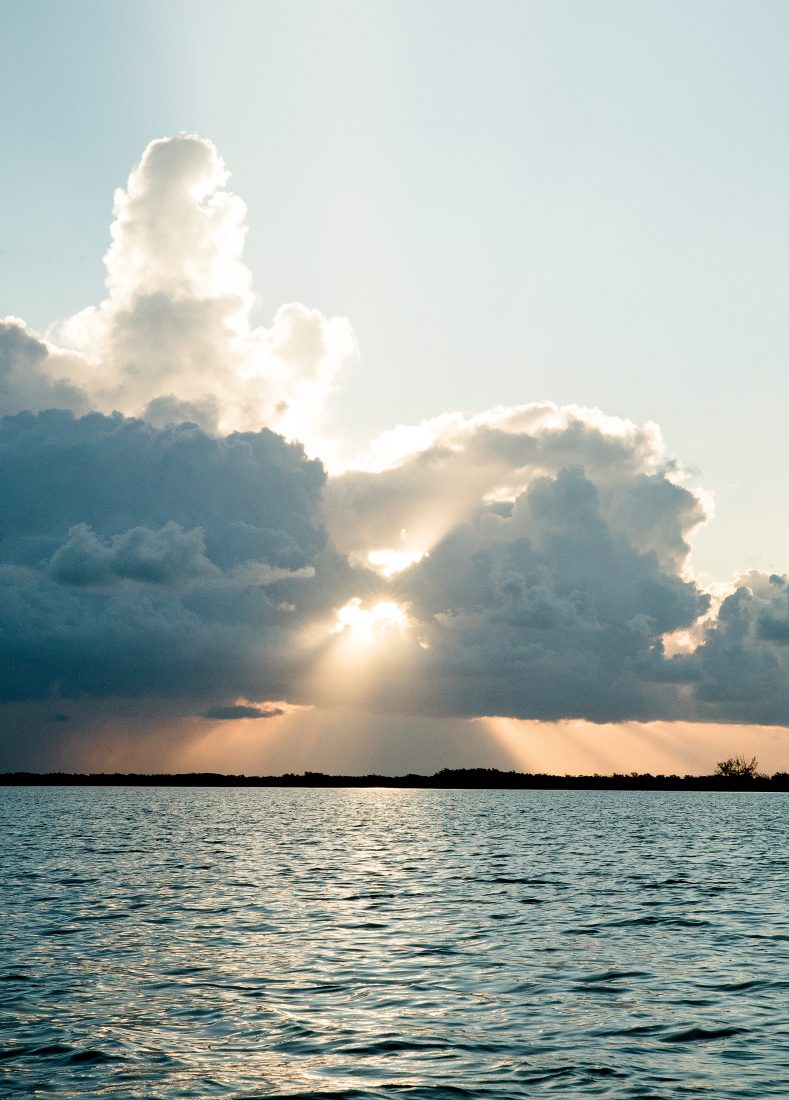
Robb Aaron Gordon
On the Water
Another fishing day begins in the Florida Keys.
It’s impossible to talk about Mill without talking about his marriage, mainly because Mill so willingly discusses it.
One night, in a crowded Keys fish house, I ask him about Evert. He gets maybe four words out before his face falls and tears begin streaming from his eyes. “I’m sorry, man,” he says. “I cry a lot.”
Mill first met Evert at a New Year’s Eve party at the Hotel Jerome in Aspen in 1986. She’d been invited there by her friend and on-court rival Martina Navratilova. Mill sat next to Evert at dinner. The next morning, they skied together. “I had never been on skis, and I was petrified,” Evert says. “Andy told Martina that he would get me down the hill. I ended up skipping the Australian Open and staying there with him.” A year and a half later, they married.
Mill traveled with her to tennis matches around the world. He met Pope John Paul II and Margaret Thatcher, and became a sort of Forrest Gump figure in U.S. presidential politics. Mill and Evert were with President George H. W. Bush at Camp David on the weekend after Iraq invaded Kuwait. At six o’clock that Sunday morning, Mill heard a knock at his door. “It was President Bush,” he says. “He said, ‘Andy, I can’t sleep. Want to go shoot some skeet?’”
Mill and Evert were also guests of Bill Clinton’s at a White House dinner on the day after the Monica Lewinsky scandal broke. Mill spent half an hour talking to Clinton about how he was dealing with the fallout and still carrying on with his presidential duties.
Mill and Evert had three boys—Alex, Nicky, and Colton—in a span of five years. The family split its time between their houses in Boca Raton and Aspen. Mill says they did everything together—hiking, fishing, riding motorcycles. “Those were the best times of my life,” he says.
It all came to an abrupt halt. “Look, nobody died, but it was a tragedy,” Mill says. “We had a great family, a great dynamic, and great passion. And then, all of a sudden, I woke up one day and she’s gone, the kids are gone, the house is gone, and we all just got really disconnected. It’s been a rough road in a number of ways.”
That Evert left Mill for the golfer Greg Norman complicated matters even more. (The two married in 2008 and have since divorced.) Mill recites a rather masterful quote he gave to the Australian media at the time: “Greg Norman at one time was my best friend, and a year and a half ago, I would have taken a bullet for this guy. But I didn’t realize he was the one who was going to pull the trigger.”
“I totally understand all of that from his perspective,” Evert says. “These things just happen. They even happen to good people.”
Mill says he cried for three years and lost thirty pounds. “Therapy and Jack Daniel’s didn’t help,” he says. “I couldn’t fish or play golf. I was a mess, but I own it. I realize that I had something to do with it. And then, one day, I woke up and decided I was sick and tired of being sick and tired, and got on with life.”
Mill and Evert are now great friends. “I love her. She’s the mother of my children. We still have a great family. She asked me the other day if I would be there with her on her deathbed. I will. And she would be there with me on mine.” Says Evert: “We have each other’s backs, for sure.”
Just as Mill is wiping away the tears, a man walks up to our table, as if scripted. “Are you the Andy Mill?” he asks. “Do you mind if I get a picture with you?”
“I’d be honored,” Mill says, as a smile quickly returns to his face.
Before the 2015 Golden Fly Tournament, Mill received a phone call from Rob Fordyce, a guide. Fordyce’s angler had dropped out. He wanted to know if Mill, nearly a decade removed from his last tournament, would fill in. Mill said yes.
Mill and Fordyce began the last day of the tournament close to 180 pounds behind the leader, a seemingly insurmountable deficit. But Mill landed two big fish that day to come from behind and win (his sixth Golden Fly title). “That was the last one,” he says. “I swear.”
Now, he says, he fishes out of pure enjoyment. “The game played with these fish is so compelling. I’ve been fascinated with it for three decades now. Every fish is different. Every cast is different.”
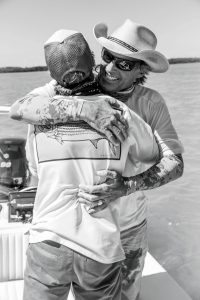
Robb Aaron Gordon
Father and son share a moment.
And, of course, there is Nicky. He is not a carbon copy of his father. His cast is quicker and more powerful but equally effective. Nicky prefers the backhand cast—a useful weapon in the quick-twitch game of tarpon fishing, where fish sometimes appear out of nowhere. That favoritism should come as no surprise given his maternity. Nicky also takes after his mother in his looks and demeanor—the strong cheekbones, the steely squint to his eyes, and the quiet determination that belies a fierce competitiveness within.
Mill and Nicky occasionally bicker a bit, as anyone would when spending up to twelve hours a day on a sixteen-foot skiff. (“Dad, you’re poling too fast.” “No, I’m not.” “Yes, you are. Slow down.”) But most of the time, the banter is warm and affirmative. (“That was a pretty good cast, right, Dad?” “It was perfect, Nicky.”) It reveals two minds that have begun to meld. (“What do you think about pushing off for that bar, Nicky?” “That’s exactly what I was thinking.”)
Nicky says he’s not sure if he wants to become a full-time tournament angler. But, as his father once did, he believes it’s time to see just how good he’s become. In the process, it seems, something more important has been found. “I love being out here with him every day and seeing his heart and passion,” Mill says. “I’m just really proud of him.”



